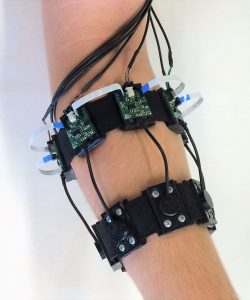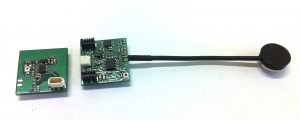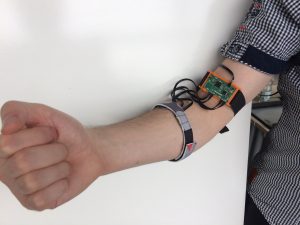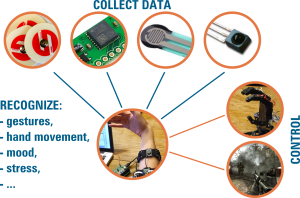B-AND technology aims to provide comprehensive information about its user’s forearm activity, allowing fork new ways in human-machine interoperability. The key to this lies in applying sensor fusion combining arm motion interface, with extended biological signal information: EMG or skin deformation. Merging data from several sources allows for advanced hand and arm gesture recognition, with high reliability levels. Form of a forearm-placed band makes it easy and intuitive to use.
We have built a set of custom miniature EMG amplifiers . To provide modularity and environmental interference resistance bipolar amplifier is an independent active electrode, which can be connected with an analogue bus. A set of seven amplifiers was put on an elastic band with 3D-printed reusable gel electrodes, creating a 7-channel forearm EMG acquisition device. The same setup can be easily adjusted to include a different number of channels or electrode placement.
. To provide modularity and environmental interference resistance bipolar amplifier is an independent active electrode, which can be connected with an analogue bus. A set of seven amplifiers was put on an elastic band with 3D-printed reusable gel electrodes, creating a 7-channel forearm EMG acquisition device. The same setup can be easily adjusted to include a different number of channels or electrode placement.
 All amplifiers use a common DRL circuit, which further improves external interference resistance.
All amplifiers use a common DRL circuit, which further improves external interference resistance.
Another way of muscle activity assessment is through mechanomyography. We developed a mechanomyographical band based on IMU sensors which can pick up vibrations generated by mu scle tension and skin deformations caused by muscle movement under skin surface. The band is highly reconfigurable, with 8 sensors found to be sufficient for forearm muscle activity acquisition.
scle tension and skin deformations caused by muscle movement under skin surface. The band is highly reconfigurable, with 8 sensors found to be sufficient for forearm muscle activity acquisition.

